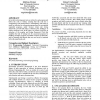47 search results - page 2 / 10 » Detecting Redundant Unit Tests for AspectJ Programs |
SOPR
2008
13 years 5 months ago
2008
Pair programming is regarded as one of the practices that can make testing more rigorous, thorough and effective. Therefore, we examined pair programming vs. solo programming with ...
PPPJ
2009
ACM
14 years 9 days ago
2009
ACM
In test-driven development, tests are written for each program unit before the code is written, ensuring that the code has a comprehensive unit testing harness. Unfortunately, uni...
JOT
2007
13 years 5 months ago
2007
Aspect-Oriented Programming is an emerging software engineering paradigm. It offers new constructs and tools improving separation of crosscutting concerns into single units called...
AOSD
2008
ACM
13 years 7 months ago
2008
ACM
We propose test-based pointcuts, a novel pointcut mechanism for AspectJ-like aspect-oriented programming languages. The idea behind the test-based pointcuts is to specify join poi...
DSN
2007
IEEE
13 years 12 months ago
2007
IEEE
A new approach is proposed that exploits repetition inherent in programs to provide low-overhead transient fault protection in a processor. Programs repeatedly execute the same in...

